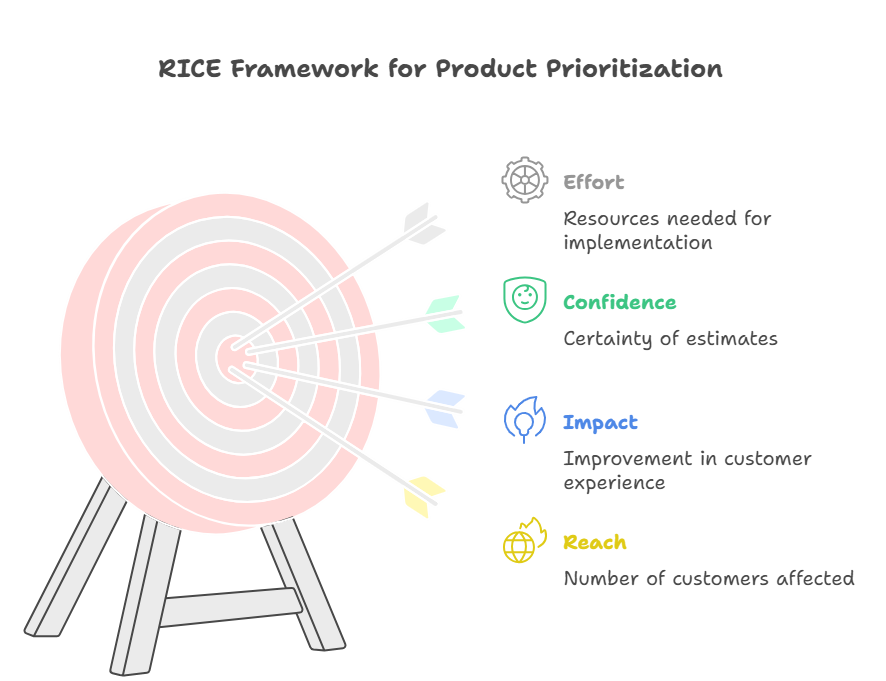How to Prioritize Customer Feedback: A Strategic Framework
Learn how to effectively prioritize customer feedback using proven frameworks like RICE and practical strategies that align with your product goals and business vision.
Introduction
Customer feedback is both a blessing and a curse for product teams. While it provides invaluable insights into user needs, the sheer volume can quickly become overwhelming. The challenge isn't just collecting feedback—it's determining which feedback deserves immediate attention and which can wait. Effective prioritization means aligning feedback with your product goals and your company's strategic vision, ensuring that every decision moves your product forward in a meaningful way.
Why Feedback Prioritization Matters
Without a systematic approach to feedback prioritization, teams risk wasting resources on low-impact features while missing critical opportunities. When you place a premium on user feedback, you position customers at the heart of your product development process. This ensures your business stays aligned with evolving consumer needs and market shifts, creating products that genuinely resonate with your target audience.
The consequences of poor prioritization extend beyond wasted effort. As HubSpot notes, "If a customer tells you the exact same feedback twice, meaning you didn't address the issue after they raised it in the first survey, you will lose credibility and they may not be willing to keep filling out your surveys in the future."
The RICE Framework for Feedback Prioritization
One of the most effective methods for prioritizing customer feedback is the RICE framework, which helps teams prioritize what brings value to both the user and the company. RICE stands for Reach, Impact, Confidence, and Effort:

- Reach: How many customers will this affect within a given timeframe?
- Impact: How significantly will this change improve the customer experience?
- Confidence: How certain are you about your reach and impact estimates?
- Effort: How much time and resources will implementing this feedback require?
By scoring feedback across these four dimensions, you create an objective basis for comparison that transcends individual opinions and biases. For teams looking to implement this approach quickly, ClipMind's RICE Analyzer provides a structured way to evaluate and compare feedback items systematically.
Building Your Feedback Prioritization Process
Collect and Centralize Feedback
Start by gathering feedback from all available channels—support tickets, surveys, user interviews, and social media. The key is creating a single source of truth where all feedback can be reviewed and analyzed together. Tools like Productboard streamline this process by integrating multiple feedback sources into a centralized platform.
Categorize and Tag Feedback
Organize feedback into meaningful categories such as bug reports, feature requests, usability issues, or enhancement suggestions. Automatic tagging and categorization features, available in platforms like Usersnap, can significantly speed up this process while ensuring consistency.
Evaluate Against Strategic Goals
Not all valuable feedback aligns with your current strategic direction. Evaluate each piece of feedback against your product roadmap and business objectives. Ask critical questions: Does this support our key metrics? Will this help us enter new markets? Does this strengthen our competitive advantage?
Communicate Decisions and Updates
Once you've prioritized feedback, communication becomes crucial. Let customers know when their suggestions are being implemented and provide transparency about your decision-making process. As Usersnap emphasizes, acting on and communicating about feedback builds trust and encourages continued engagement.
Practical Prioritization Strategies
Focus on High-Impact, Low-Effort Opportunities
Start with feedback that delivers significant value with minimal implementation effort. These quick wins demonstrate your responsiveness to customer needs while building momentum for larger initiatives.
Consider Customer Value and Loyalty
Some customers warrant special attention. As Gorgias suggests, responding to your most loyal customers first and tagging repeat customers as high-priority can strengthen key relationships.
Look for Patterns and Frequency
Single requests might represent individual preferences, but repeated feedback across multiple customers often indicates broader needs. Track how frequently similar feedback appears to identify trends that deserve prioritization.
Balance Short-term and Long-term Value
While immediate customer needs matter, don't neglect feedback that supports long-term strategic goals. The most effective prioritization balances quick fixes with foundational improvements that will pay dividends over time.
Maintaining Your Prioritization System
Feedback prioritization isn't a one-time activity but an ongoing process. Regularly reassess feedback, update your roadmap, and gather input to keep your product aligned with customer needs and business goals. As your product evolves and your customer base grows, your prioritization criteria may need adjustment.
Visualizing Your Feedback Prioritization
For visual thinkers and teams that benefit from clear frameworks, creating a mind map of your feedback prioritization process can provide valuable clarity. ClipMind offers tools to visualize how different feedback items connect to your strategic objectives, making it easier to communicate priorities across your organization.
Conclusion
Effective customer feedback prioritization transforms overwhelming input into actionable insights. By implementing a structured approach that combines frameworks like RICE with clear strategic alignment, you can ensure that your product development efforts consistently deliver maximum value to both customers and your business. Remember that the goal isn't to implement every piece of feedback but to make informed decisions about which feedback will drive your product forward most effectively.
 ClipMind
ClipMind